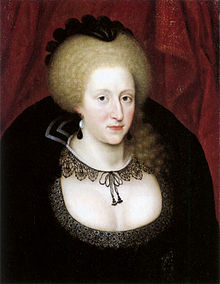| Sign of Hertoghe | |
|---|---|
| Other names | Queen Anne's sign |
 | |
| Anne of Denmark mourning the death of her son Henry in 1612 | |
| Differential diagnosis | hypothyroidism |
The Sign of Hertoghe or Queen Anne's sign is a thinning or loss of the outer third of the eyebrows, and is a classical sign of hypothyroidism or atopic dermatitis,[1][2][3] but it can also be detected in lepromatous leprosy.[4] The sign is named after the Belgian Internist Eugene Ludovic Christian Hertoghe (April 5, 1860–January 3, 1928), who was a native of Antwerp, and was the first pioneer in thyroid function research.[2][3][5]
- ^ Ständer, Sonja (2021-03-25). "Atopic Dermatitis". New England Journal of Medicine. 384 (12): 1136–1143. doi:10.1056/NEJMra2023911. PMID 33761208. S2CID 232355341.
- ^ a b Schatz, Henry A. (May 1922). "The Role of the Thyroid Gland in Otolaryngology". The Pennsylvania Medical Journal. 25 (8): 529.
- ^ a b "Complimentary Dinner given by Dr. William Seaman Bainbridge". American Medicine. 9 (4): 308. April 1914. Retrieved 2014-12-12.
- ^ Parrino, Daniela; Di Bella, Stefano (2016-03-29). "Hertoghe sign: an hallmark of lepromatous leprosy". QJM: Monthly Journal of the Association of Physicians. 109 (7): 497. doi:10.1093/qjmed/hcw046. ISSN 1460-2393. PMID 27026695.
- ^ "Eugène Ludovic Christian Hertoghe (1860-1928) » van Lerberghe genealogy » Genealogy Online".